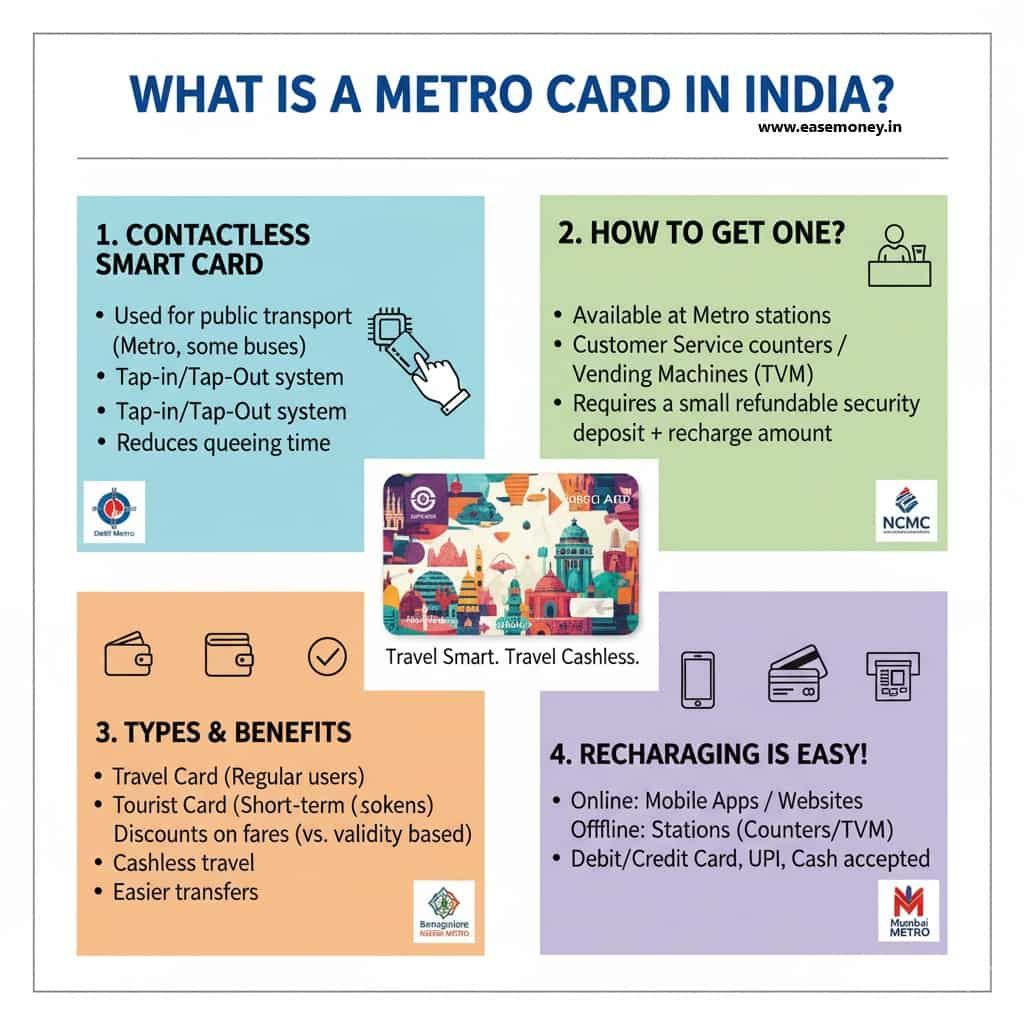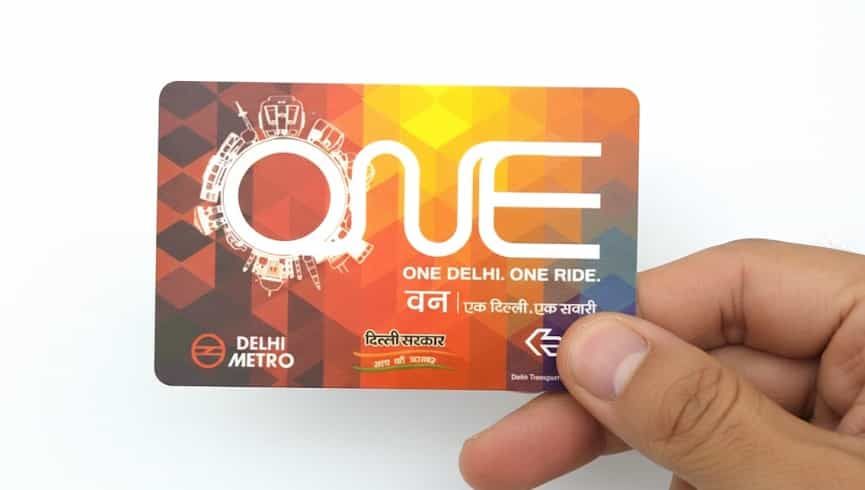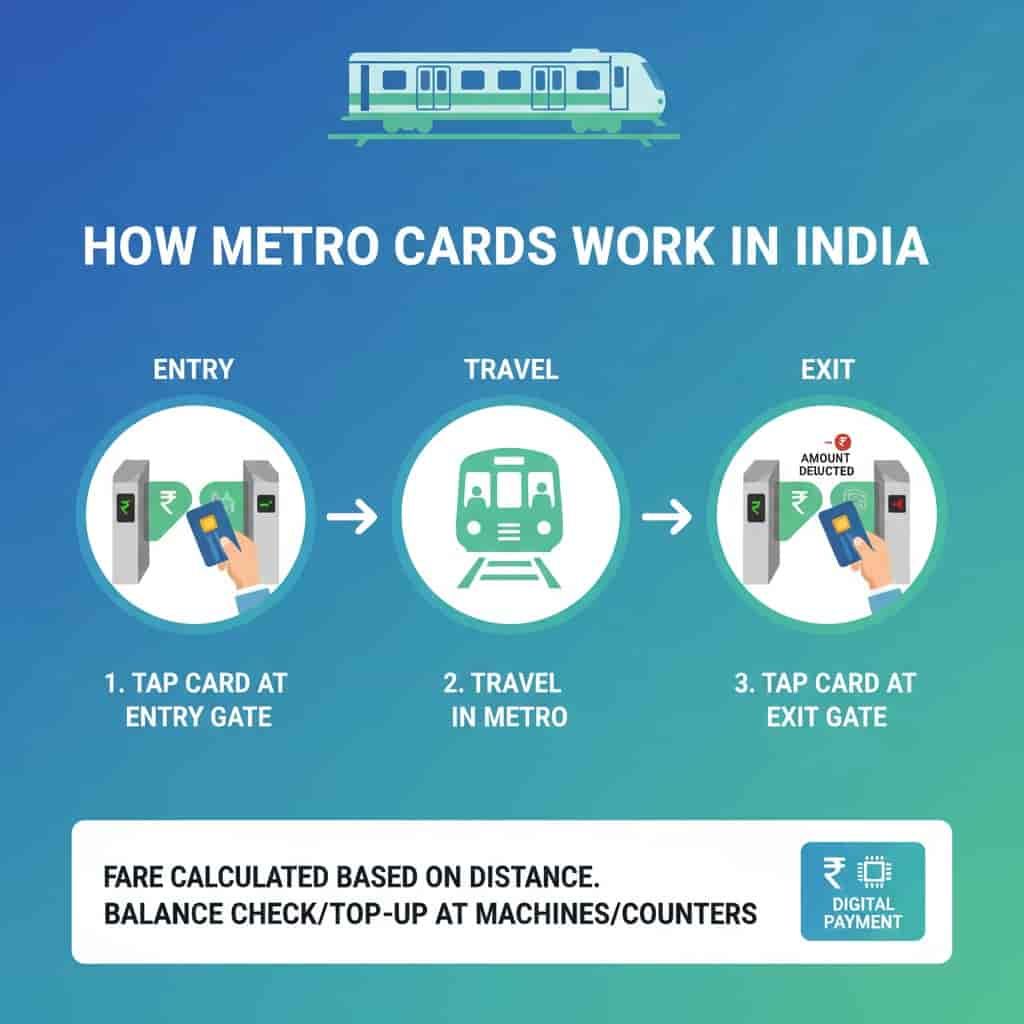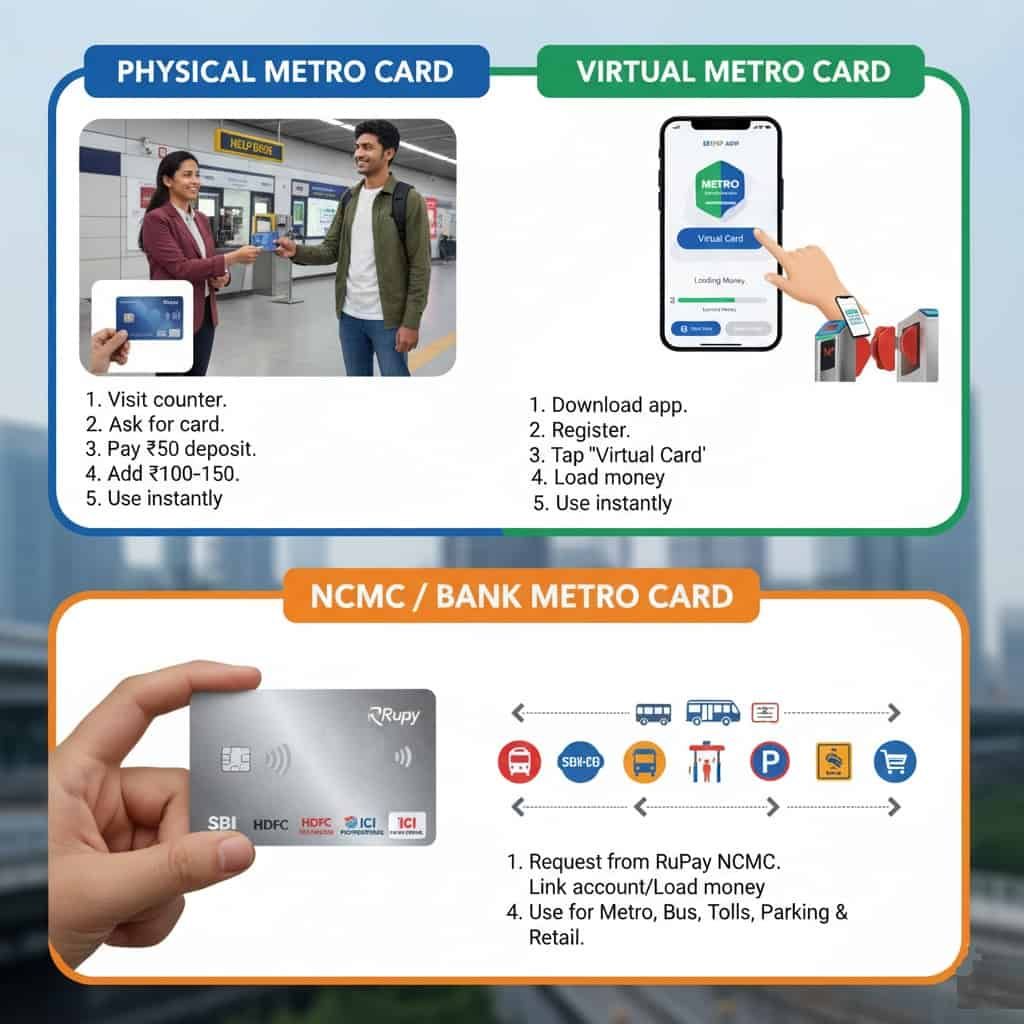A Metro Card is a prepaid smart card issued by your Metro Rail corporation. In India, there are 23 cities with operational metro rail systems; each city has a different card for you. It acts like a digital wallet for travelling in your city.

It allows passengers like you to pay for journeys without having to purchase paper or coin tokens every time. Also, helps to skip the time to standing in queues for tickets.
According to RBI guidelines, Metro cards are classified as closed-loop prepaid payment instruments (PPIs); in simple words, they can generally be used only within the issuing metro system.
This card is designed for fare discounts and to reduce the use of cash and paper tickets. Depending on your city, a card may exist in physical form, virtual format on mobile apps, or even QR-based tickets, and may also be compatible with National Common Mobility Cards (NCMC Ru-Pay).
Quick Example –

- Delhi One Card – This is the most popular physical card till 2024 in India, works across Delhi metro lines. but,
- As per the Official DMRC X handle, they closed issuing new One Metro cards.
- From September, 2024, they will start the Delhi Metro Virtual card, which is available on Delhi Metro mobile apps. You can directly apply for it.
How Metro Cards Work
Metro cards operate on a tap-in, tap-out system. When you enter a station,

- Tap the card at the entry gate (AFC) with a Card symbol. (back or front, both work)
- Travel to your destination.
- Tap at the exit gate, and the system deducts the correct fare.
If your balance is below the minimum required fare, the gate won’t open, and you need to recharge the card.
After 2024, most metros have added digital innovations, such as the Delhi Metro now offering online multiple Journey QR Tickets (MJQRT). As per its name, it allows multiple trips using a single QR code using your phone only.
Similarly, Bengaluru, Mumbai, and Hyderabad metros have begun integrating NCMC / RuPay-based cards. You can use across multiple transport modes and partner services.
Different Types of Metro Travel Cards in India
1. Physical Metro Card
- A plastic smart card is issued at the metro counters.
- You have to pay a security deposit of around ₹50–100; however, it is refundable.
- You have to start with a minimum balance (typically ₹150) to start using it.
- Rechargeable offline at stations, or you can simply use the metro app to load money, or you can use UPI Apps such as CRED, PAYTM, and Phonepe.
- Offers 10–15% fare discounts depending on the city.
2. Virtual Metro Card
- Exists only in digital form on metro apps (no plastic card).
- It can be obtained by downloading the official city metro app, logging in, selecting the virtual card, and loading money.
- Works just like a physical card, including discounts on fares.
- Depending on your location, you can apply for it using metro apps such as – Delhi Metro Sarathi app, Bengaluru Namma Metro app, and Hyderabad TSavaari app.
- RBI and Digital India promote this because it is Eco-friendly, convenient, and recoverable if your device is lost.
3. Multiple Journey QR Ticket (MJQRT) – Delhi Metro
- First-of-its-kind QR-based ticket for multiple journeys, you can put money and use it anywhere in your city.
- Available on the Delhi Sarathi (Momentum 2.0) app.
- You have to load money in multiples of ₹50, maximum ₹3,000 only; the minimum balance for travel is ₹60.
- Discounts: 10% peak hours, 20% off-peak.
- No deposit required; balance recoverable if phone is lost.
4. National Common Mobility Card (NCMC) / Bank Metro Cards
- RuPay-based cards worked across metros, buses, tolls, parking, and select retail outlets.
- It can be linked to a bank account, making recharge simple.
- Example: SBI Mumbai Metro Card – functions as both a metro card and an NCMC card.
- Offers metro fare discounts while also working for other transport modes.
Lost card? Balance can be restored or transferred. You can request a replacement; however, it has normal charges. - Some metros, like Mumbai Metro Line 3, are fully NCMC-enabled, allowing passengers to tap-and-go without separate metro cards.
How to Get a Metro Card

Physical Metro Card
- Depending on your city, you have to visit the help desk or ticket counter at the nearest metro station.
- Ask for a physical MetroCard. Provide your basic details.
- Pay a refundable deposit (usually ₹50).
- Add a minimum balance (₹100–150).
- Card issued instantly; start using it immediately.
Virtual Metro Card
- It’s really simple for you, just download your city’s metro app.
- Register with your mobile number.
- Tap on the Virtual Card option.
- Load money via UPI, debit, or credit card.
- Start using it at the metro gates; enjoy the same discounts as physical cards.
NCMC / Bank Metro Card
- You can request it from partner banks (SBI, HDFC, ICICI, Airtel Payments Bank) or metro help desks.
- Apply for a RuPay-based NCMC card or a bank metro card.
- Link to your bank account or load money.
- Use for metro travel, buses, tolls, parking, and select retail purchases.
City-Wise Metro Cards (2025)
Here’s a summary table of metro cards in major Indian cities:
| City | Card Type | Recharge Options | Discounts / Notes |
|---|---|---|---|
| Delhi | Physical, Virtual, MJQRT, NCMC | WhatsApp, the smartcard official website by DMRC | Smart card 10%, MJQRT 10–20%, NCMC accepted |
| Bengaluru | Physical, Virtual, NCMC | Amazon Pay, Mobile App; minimum balance ₹90 | 5–10% discounts, extra on Sundays & holidays |
| Mumbai | Physical, SBI Mumbai Card | Online/offline; initial top-up ₹100 | NCMC accepted on Metro Line 3; unified travel across lines & buses |
| Hyderabad | Physical, Virtual, NCMC | Online/offline; multiples of ₹50 | Smart card ~₹100; balance recoverable if lost; NCMC adoption ongoing |
| Chennai | Physical, NCMC | Online/offline | Physical cards are usable; new users are encouraged to use NCMC |
| Kolkata | Physical or Digital | Offline recharge or use the Web portal | The Oldest metro; smart cards offer a 10–15% discount |
Metro Card Charges & Minimum Balance
- Security Deposit: For most physical cards, you have to first pay a small fee between ₹50 and 100 for enrollment.
- Minimum Balance: To apply for a physical or virtual card, you have to load at least Rs. 100 to Rs. 150.
- Card Active Charges: There is no mandatory, but keep maintaining upto ₹40–150 depending on the city.
- Replacement Fee: ₹50–100 for lost/damaged cards.
- Discounts: 5–20% depending on city, time, and card type.
Tip – Virtual cards usually do not require a deposit for applying, same as MJQRT also works without any charges or extra fees.
How to Recharge Your Metro Card
- Offline: If you have cash, visit your Station ticket counters and pay and load it, or just use smart card vending machines.
- Online: City metro app, Metro portals, WhatsApp Booking, or choose any UPI apps (Paytm, PhonePe, Google Pay).
- Virtual Card: You can manage and do your recharge directly in-app; the balance is usable immediately.
- Validation: After recharging your physical card, you may have to use the Metro station machine to top up the plan.
Read – How to Check Metro Card Balance Online or Offline
Future Trends (After 2025)
- Just like Delhi Metro did, now most of the metros are continuously shifting from physical cards to virtual, the token system, and Paper slips will end soon all over cities.
- RBI and NPCI are pushing travellers to choose NCMC Cards, because it is a single RuPay card for all urban transport and payments.
- Integration with buses, tolls, parking, and retail for unified mobility.
Additional FAQs
Can I use one Metro card for multiple family members travelling together?
Yes, but only if you recharge a sufficient balance. Your family member needs to tap one by one at the entry and exit gates.
Is there any discount available for frequent Metro travellers using smart cards?
Yes, most Metro systems provide travel discounts ranging between 5–15% per ride when using a smart physical or virtual card; however, the discount depends on the peak hours.
What happens if my Metro card balance becomes negative after a ride?
This happens if your travel ticket price is Rs. 40 and your card has only Rs. 30, then it goes negative for Rs. 10; however, you have to recharge to maintain the negative balance. Otherwise, the card cannot be used for future travel until settled.
Are Metro cards valid across multiple cities in India, or only in one city?
Generally, MetroCards are city-specific. A Delhi Metro card won’t work in Mumbai or Bangalore. Each city operates its own smart card system, but you can choose the NCMC Bank single card across india.
Join 60,000 readers who get exclusive credit and banking deals, RBI updates, and investment insights from Easemoney.